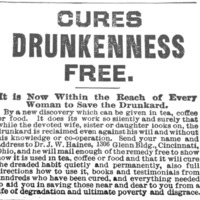"Cures Drunkenness Free" Collier’s Weekly. 23 Dec. 1899.
Title
"Cures Drunkenness Free" Collier’s Weekly. 23 Dec. 1899.
Description
The item I chose is an advertisement that highlights a remedy used to cure alcoholism. Women are the main audience of the advertisement but are not the intended users of the drug. Instead, it is suggested that women sneak the drug into the drinks and food of the alcoholic they are trying to cure with their consent. The author of the advertisement and creator of the drug is a man named Dr. J. W. Haines, located in Cincinnati, who is happy to send you a trial package of the drug for no cost at all. Finding more information on Dr. J. W. Haines was a tough feat considering there are, surprisingly, many present-day doctors of the same name who are much more credible. However, I was able to find some interesting facts on the doctor (whether or not they are reliable is up to interpretation but I thought I would include them because they are funny nonetheless). Dr. Haines had far too long of a run and it wasn’t until 1917 that the American Medical Association decided that what he was advertising probably was not good. They denounced his remedy after further analysis found that the substance contained milk sugar, starch, capsicum and a tiny bit of ipecac. Ipecac is a drug used to induce vomiting. So, in theory, Dr. Haines was attempting to associate drinking alcohol with vomiting to, therefore, stop the bad habit. However, there was not enough ipecac in the substance to differentiate between the vomiting that regularly occurs when one has had too much to drink and the vomiting that the drug was supposed to induce. What I found most interesting about the advertisement was that it was not aimed at the alcoholics themselves, but rather their family members. The substance was completely odor-free and tasteless so anyone could sneak it into the drunkard’s coffee or tea without the user knowing. The advertisement specifically says, “The drunkard is reclaimed even against his will and without his knowledge or cooperation.” There is something about this line that makes my stomach lurch. It is well known today that you cannot just force any person to do something they do not want to do. Even in cases of rehab, unless it is court ordered, anybody can check themselves out if they so desire. This advertisement relates to the works we have read in class because it shows how alcoholism was a rising problem during the 1890s. As shown in Maggie: Girl of the Streets, alcoholism plagued and destroyed lives, especially in lower class areas. At the end of the advertisement it harshly says, “Everything needed to aid you in saving those near and dear to you from a life of degradation and ultimate poverty and disgrace.” Maggie’s family experienced poverty and violence because of her mother’s alcoholism.
Creator
Dr. J. W. Haines
Source
“Cures Drunkenness Free.” Collier’s Weekly. 23 Dec. 1899: Page 19. Print.
Publisher
Collier's Weekly
Date
23 Dec. 1899
Contributor
Jessa Laspesa
Files
Collection
Citation
Dr. J. W. Haines, “"Cures Drunkenness Free" Collier’s Weekly. 23 Dec. 1899. ,” Three Decades of NYC, accessed December 13, 2025, http://www.loyolanotredamelib.org/en203/items/show/52.

